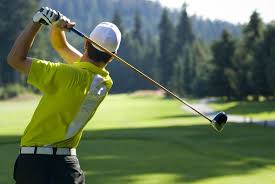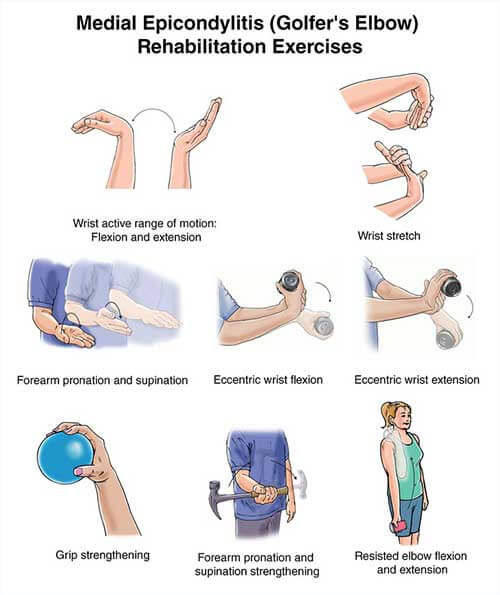Golfer’s elbow

Golfer's elbow is a condition that causes pain where the tendons of your forearm muscles attach to the bony bump on the inside of your elbow. The pain might spread into your forearm and wrist.
Golfer's elbow is similar to tennis elbow, which occurs on the outside of the elbow. It's not limited to golfers. Tennis players and others who repeatedly use their wrists or clench their fingers also can develop golfer's elbow.
The pain of golfer's elbow doesn't have to keep you off the course or away from your favorite activities. Rest and appropriate treatment can get you back into the swing of things.
Symptoms
Golfer's elbow is characterized by:
• Pain and tenderness on the inner side of your elbow. Sometimes the pain extends along the inner side of your forearm. Pain typically worsens with certain movements.

• Stiffness. Your elbow may feel stiff, and it may hurt to make a fist.
The pain of golfer's elbow can come on suddenly or gradually. The pain might worsen when you:
• Swing a golf club or racket
• Squeeze or pitch a ball
• Shake hands
• Turn a doorknob
• Lift weights
• Pick up something with your palm down
• Flex your wrist
Golfer's elbow, also known as medial epicondylitis, is caused by damage to the muscles and tendons that control your wrist and fingers. The damage is typically related to excess or repeated stress — especially forceful wrist and finger motions. Improper lifting, throwing or hitting, as well as too little warm-up or poor conditioning, also can contribute to golfer's elbow.
Many activities can lead to golfer's elbow, including:
• Golf. Gripping or swinging clubs incorrectly or too forcefully can take a toll on your muscles and tendons.
• Racket sports. Excessive topspin can hurt your elbow. Using a racket that's too small or heavy also can lead to injury.
• Throwing sports. Improper pitching technique in baseball or softball can be another culprit. Football, archery and javelin throwing also can cause golfer's elbow.
• Weight training. Lifting weights using improper technique, such as curling the wrists during a biceps exercise, can overload the elbow muscles and tendons.
In addition, any activity that requires repeatedly bending and straightening your elbow can cause golfer's elbow. This includes painting, raking, hammering, chopping wood, using a computer, doing assembly-line work and cooking. A day or two of yardwork or cooking for company usually won't cause golfer's elbow, though. The activity generally needs to be done for more than an hour a day on many days to cause a problem.
Diagnosis
Golfer's elbow is usually diagnosed based on your medical history and a physical exam. To evaluate pain and stiffness, the doctor may apply pressure to the affected area or ask you to move your elbow, wrist and fingers in various ways.
An X-ray can help the doctor rule out other causes of elbow pain, such as a fracture or arthritis. Rarely, more comprehensive imaging studies — such as MRI — are performed.
Treatment
The sooner you begin treatment, the sooner you'll be able to return to your usual activities.
• Rest. Put your golf game or other repetitive activities on hold until the pain is gone. If you return to activity too soon, you may make it worse.
• Ice the affected area. Apply ice packs to your elbow for 15 to 20 minutes at a time, three to four times a day for several days. To protect your skin, wrap the ice packs in a thin towel. It might help to massage the inner elbow with ice for five minutes at a time, two to three times a day.
• Take an over-the-counter pain reliever. Try ibuprofen (Advil, Motrin IB, others), naproxen sodium (Aleve, others) or acetaminophen (Tylenol, others).
• Use a brace. Your doctor might recommend that you wear a counter force brace on your affected arm, which might reduce tendon and muscle strain.

Stretch and strengthen the affected area. Your doctor may suggest stretching and strengthening exercises. Physical or occupational therapy can be helpful, too. A type of strengthening • (eccentric) that lengthens the tendon of the wrist extensor muscles has been shown to be particularly effective in treating chronic tendon irritation.

• Reduce the load on your elbow tendons. Wrap your elbow with an elastic bandage or use a splint.
• • Gradually return to your usual activities. When your pain is gone, practice the arm motions of your sport or activity. Review your golf or tennis swing with an instructor and make adjustments if needed.